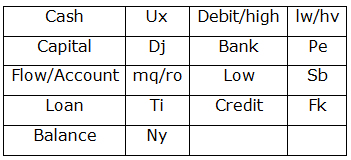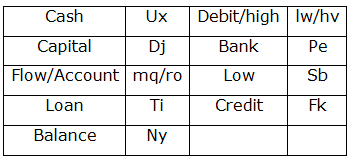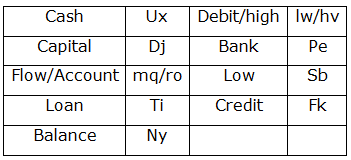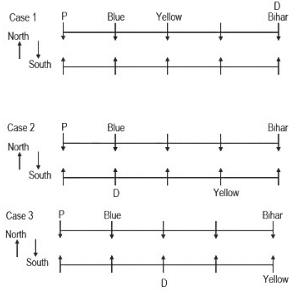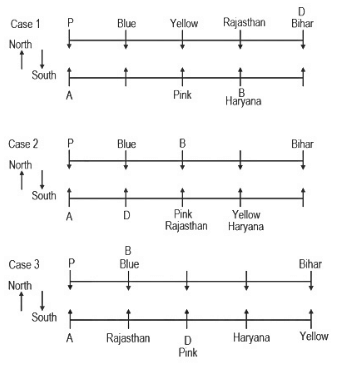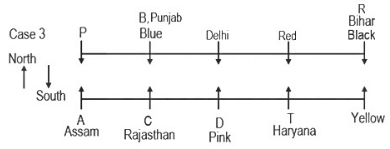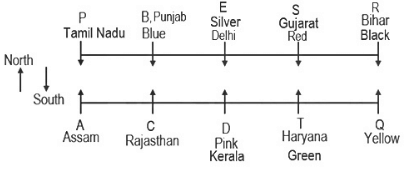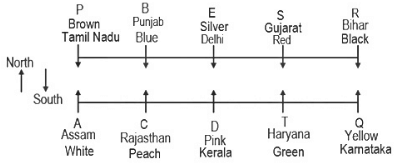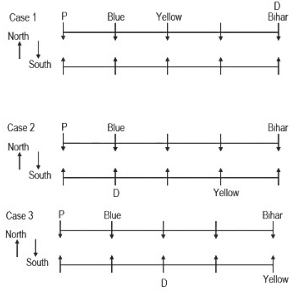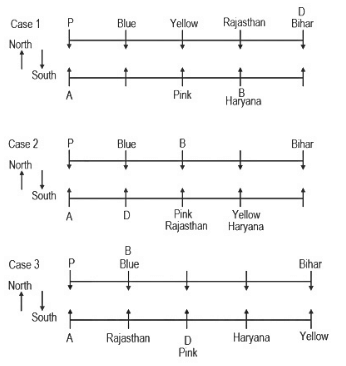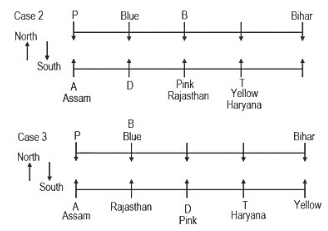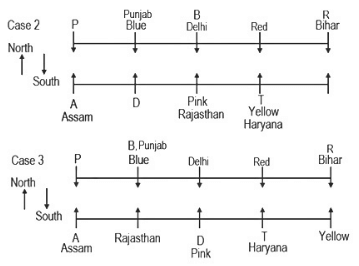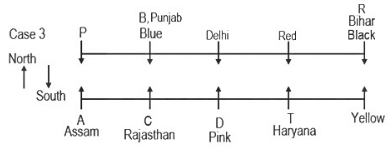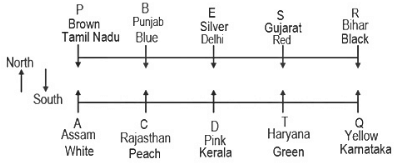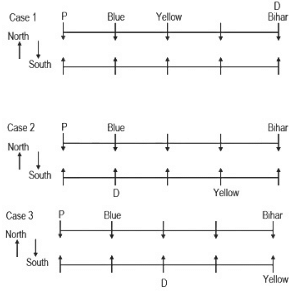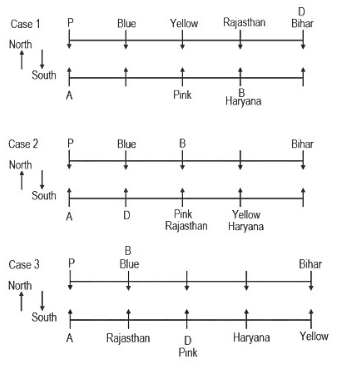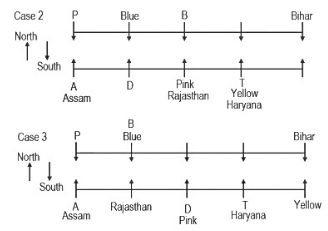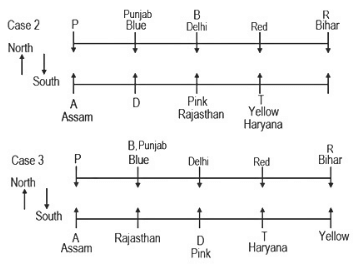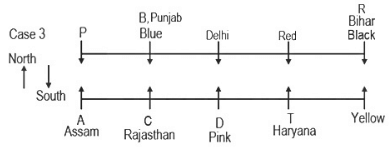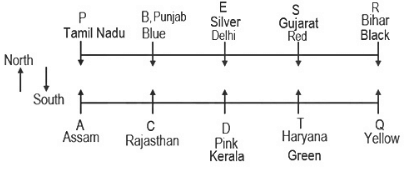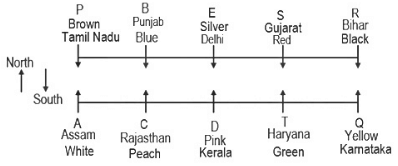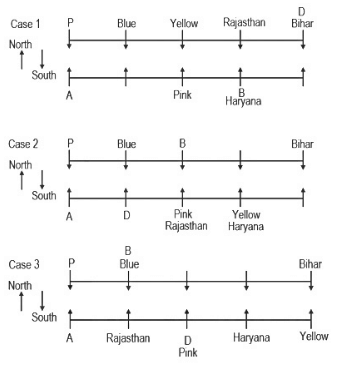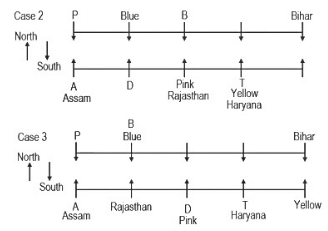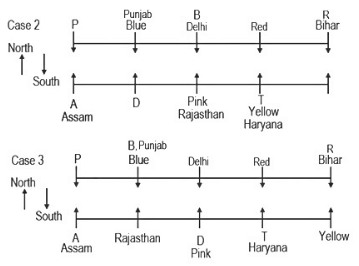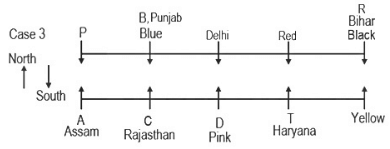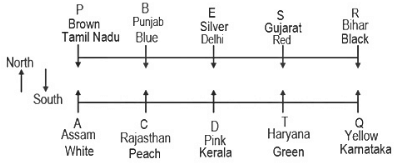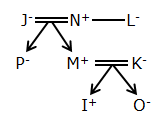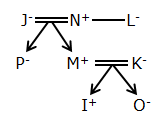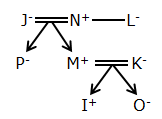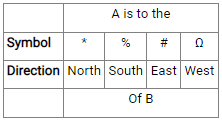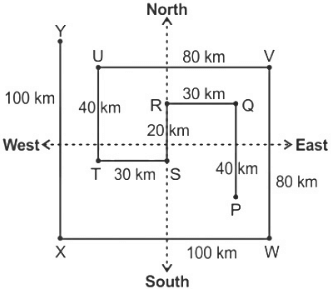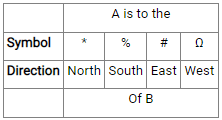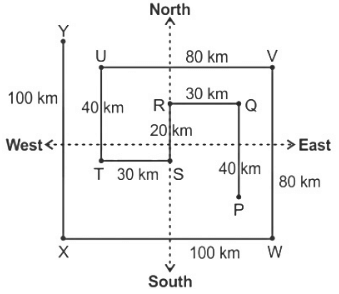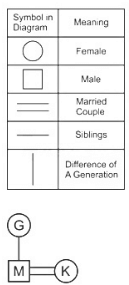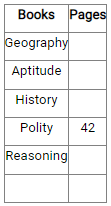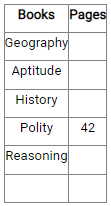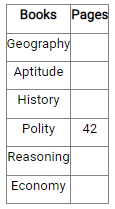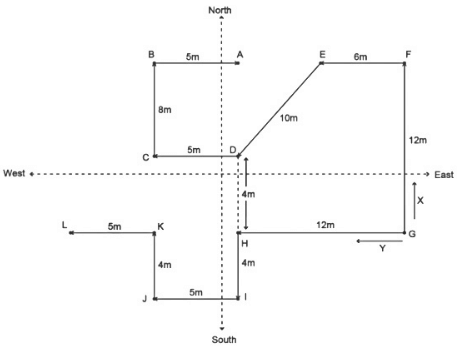IBPS RRB Clerk Mains Mock Test - 3 - Bank Exams MCQ
30 Questions MCQ Test - IBPS RRB Clerk Mains Mock Test - 3
Study the following information carefully and answer the question given below.
In a certain code language
“Bank loan debit high” means “ti pe lw hv”
“Low credit balance loan” means “fk sb ny ti”
“Capital bank cash credit” means “pe ux dj fk”
“Cash flow low account” means “sb ro mq ux”
Q. What is the possible code for the phrase “bank flow high” respectively in the given code language?
Study the following information carefully and answer the question given below.
In a certain code language
“Bank loan debit high” means “ti pe lw hv”
“Low credit balance loan” means “fk sb ny ti”
“Capital bank cash credit” means “pe ux dj fk”
“Cash flow low account” means “sb ro mq ux”
Q. What does the code “fk ux mq” represent in the given code language?
Study the following information carefully and answer the question given below.
In a certain code language
“Bank loan debit high” means “ti pe lw hv”
“Low credit balance loan” means “fk sb ny ti”
“Capital bank cash credit” means “pe ux dj fk”
“Cash flow low account” means “sb ro mq ux”
Q. If “High inflation account” means “mq lw cz”, then what is the possible code for the phrase “Debit deflation flow” in the given coded language?
Direction: Read the following information carefully and answer the question that follow:
Ten people - A, B, C, D, E, P, Q, R, S and T are sitting in two rows with five persons in each row, not necessarily in the same order. Each person in row one is facing south and each person in other row is facing north. Each person in row one faces a person from the other row. Each of them belongs to different states - Delhi, Tamil Nadu, Gujarat, Rajasthan, Punjab, Bihar, Karnataka, Haryana, Assam and Kerala. All of them likes different colours - Red, Green, Blue, White, Peach, Black, Yellow, Brown, Silver and Pink. The one who belongs to Bihar is sitting third to the left of blue. P is not facing north but is sitting immediate right of the one who likes blue. The one who likes yellow is sitting second to the right of D. P neither likes yellow nor facing to D. The one who belongs to Haryana is facing the one who is sitting third to the left of P. A is sitting third to the left of the one who belongs to Haryana. Only one person is sitting between A and the one who likes pink. B is facing to the one who belongs to Rajasthan. D is an immediate neighbour of the one who belongs to Rajasthan. T is sitting third to the right of the one who belongs to Assam. T is not sitting at any of the extreme ends. Two persons are sitting between R and the one who belongs to Punjab. P doesn’t belong to Punjab. R is not an immediate neighbour of T. The one who belongs to Delhi is an immediate neighbour of the one who likes red. R is an immediate neighbour of the one who likes red. C is facing the one who is sitting third to the right of the one who likes black. A doesn’t like black. The one who belongs to Tamil Nadu is sitting second to the right of the one who likes silver. E is an immediate neighbour of the one who belongs to Gujarat. Q is sitting second to the right of the one who belongs to Kerala. S is facing the one who likes Green. The one who likes white is sitting immediate left of the one who likes peach.
Q. Who among the following likes peach colour?
Direction: Read the following information carefully and answer the question that follow:
Ten people - A, B, C, D, E, P, Q, R, S and T are sitting in two rows with five persons in each row, not necessarily in the same order. Each person in row one is facing south and each person in other row is facing north. Each person in row one faces a person from the other row. Each of them belongs to different states - Delhi, Tamil Nadu, Gujarat, Rajasthan, Punjab, Bihar, Karnataka, Haryana, Assam and Kerala. All of them likes different colours - Red, Green, Blue, White, Peach, Black, Yellow, Brown, Silver and Pink. The one who belongs to Bihar is sitting third to the left of blue. P is not facing north but is sitting immediate right of the one who likes blue. The one who likes yellow is sitting second to the right of D. P neither likes yellow nor facing to D. The one who belongs to Haryana is facing the one who is sitting third to the left of P. A is sitting third to the left of the one who belongs to Haryana. Only one person is sitting between A and the one who likes pink. B is facing to the one who belongs to Rajasthan. D is an immediate neighbour of the one who belongs to Rajasthan. T is sitting third to the right of the one who belongs to Assam. T is not sitting at any of the extreme ends. Two persons are sitting between R and the one who belongs to Punjab. P doesn’t belong to Punjab. R is not an immediate neighbour of T. The one who belongs to Delhi is an immediate neighbour of the one who likes red. R is an immediate neighbour of the one who likes red. C is facing the one who is sitting third to the right of the one who likes black. A doesn’t like black. The one who belongs to Tamil Nadu is sitting second to the right of the one who likes silver. E is an immediate neighbour of the one who belongs to Gujarat. Q is sitting second to the right of the one who belongs to Kerala. S is facing the one who likes Green. The one who likes white is sitting immediate left of the one who likes peach.
Q. T likes which colour?
Direction: Read the following information carefully and answer the question that follow:
Ten people - A, B, C, D, E, P, Q, R, S and T are sitting in two rows with five persons in each row, not necessarily in the same order. Each person in row one is facing south and each person in other row is facing north. Each person in row one faces a person from the other row. Each of them belongs to different states - Delhi, Tamil Nadu, Gujarat, Rajasthan, Punjab, Bihar, Karnataka, Haryana, Assam and Kerala. All of them likes different colours - Red, Green, Blue, White, Peach, Black, Yellow, Brown, Silver and Pink. The one who belongs to Bihar is sitting third to the left of blue. P is not facing north but is sitting immediate right of the one who likes blue. The one who likes yellow is sitting second to the right of D. P neither likes yellow nor facing to D. The one who belongs to Haryana is facing the one who is sitting third to the left of P. A is sitting third to the left of the one who belongs to Haryana. Only one person is sitting between A and the one who likes pink. B is facing to the one who belongs to Rajasthan. D is an immediate neighbour of the one who belongs to Rajasthan. T is sitting third to the right of the one who belongs to Assam. T is not sitting at any of the extreme ends. Two persons are sitting between R and the one who belongs to Punjab. P doesn’t belong to Punjab. R is not an immediate neighbour of T. The one who belongs to Delhi is an immediate neighbour of the one who likes red. R is an immediate neighbour of the one who likes red. C is facing the one who is sitting third to the right of the one who likes black. A doesn’t like black. The one who belongs to Tamil Nadu is sitting second to the right of the one who likes silver. E is an immediate neighbour of the one who belongs to Gujarat. Q is sitting second to the right of the one who belongs to Kerala. S is facing the one who likes Green. The one who likes white is sitting immediate left of the one who likes peach.
Q. Who among the following belongs to Karnataka?
Direction: Read the following information carefully and answer the question that follow:
Ten people - A, B, C, D, E, P, Q, R, S and T are sitting in two rows with five persons in each row, not necessarily in the same order. Each person in row one is facing south and each person in other row is facing north. Each person in row one faces a person from the other row. Each of them belongs to different states - Delhi, Tamil Nadu, Gujarat, Rajasthan, Punjab, Bihar, Karnataka, Haryana, Assam and Kerala. All of them likes different colours - Red, Green, Blue, White, Peach, Black, Yellow, Brown, Silver and Pink. The one who belongs to Bihar is sitting third to the left of blue. P is not facing north but is sitting immediate right of the one who likes blue. The one who likes yellow is sitting second to the right of D. P neither likes yellow nor facing to D. The one who belongs to Haryana is facing the one who is sitting third to the left of P. A is sitting third to the left of the one who belongs to Haryana. Only one person is sitting between A and the one who likes pink. B is facing to the one who belongs to Rajasthan. D is an immediate neighbour of the one who belongs to Rajasthan. T is sitting third to the right of the one who belongs to Assam. T is not sitting at any of the extreme ends. Two persons are sitting between R and the one who belongs to Punjab. P doesn’t belong to Punjab. R is not an immediate neighbour of T. The one who belongs to Delhi is an immediate neighbour of the one who likes red. R is an immediate neighbour of the one who likes red. C is facing the one who is sitting third to the right of the one who likes black. A doesn’t like black. The one who belongs to Tamil Nadu is sitting second to the right of the one who likes silver. E is an immediate neighbour of the one who belongs to Gujarat. Q is sitting second to the right of the one who belongs to Kerala. S is facing the one who likes Green. The one who likes white is sitting immediate left of the one who likes peach.
Q. P belongs to which state?
Study the following information carefully and answer the questions given below
In a family of eight members with three generations. There is no single parent in the family. O is the granddaughter of K’s mother-in-law. L is the sister-in-law of J and paternal aunt of P. I is the nephew of N’s daughter. M is married to K. J is the grandmother of M’s son. K is not a father of I.
Q. How is O related to N’s daughter-in-law?
Study the following information carefully and answer the questions given below
In a family of eight members with three generations. There is no single parent in the family. O is the granddaughter of K’s mother-in-law. L is the sister-in-law of J and paternal aunt of P. I is the nephew of N’s daughter. M is married to K. J is the grandmother of M’s son. K is not a father of I.
Q. How is P related to N’s sister?
Study the following information carefully and answer the questions given below
In a family of eight members with three generations. There is no single parent in the family. O is the granddaughter of K’s mother-in-law. L is the sister-in-law of J and paternal aunt of P. I is the nephew of N’s daughter. M is married to K. J is the grandmother of M’s son. K is not a father of I.
Q. If I is married to D, then how is D related to L’s nephew?
Follow the given serie to answer the question.
J U & 5 R 3 I 7 @ & M I 6 R 2 F S @ I M $ 9 L 7 1 6 A # 9 B Z $
How many such symbols are there in the above arrangement, each of which is immediately preceded by a symbol and immediately followed by a letter?
Direction: The question is based on the following arrangement. Study the arrangement carefully to answer these question.
I 4 N 5 6 C 7 5 O 6 8 G 3 N 8 I 4 T O 8 M 5 O 3 D 3 4 6 E
After dropping all the numbers, which letter will be second to the right of the sixth letter from the left end?
Direction: The question is based on the following arrangement. Study the arrangement carefully to answer these question.
I 4 N 5 6 C 7 5 O 6 8 G 3 N 8 I 4 T O 8 M 5 O 3 D 3 4 6 E
How many such numbers are there in the above series, each of which is immediately followed by a consonant as well as preceded by a vowel?
Direction: The question is based on the following arrangement. Study the arrangement carefully to answer these questions.
I 4 N 5 6 C 7 5 O 6 8 G 3 N 8 I 4 T O 8 M 5 O 3 D 3 4 6 E
After dropping all the consonants, which element will be third to the left of the third vowel from the right end?
Study the following information carefully and answer the questions given below
Seven different branded laptops –P, Q, R, S, T, U and V are in different rates.
The rate of laptop P is more than Q, which is more than S. The rate of laptop R is more than laptop V but less than laptop U. P is the third costliest laptop and the rate of laptop S is not least. The rate of third lowest laptop is Rs.20000. The rate of laptop T is less than laptop Q. The rate of laptop V is less than at-most 3 laptops.
Q. If the sum of the rate of laptops P and S is Rs.51000 and the sum of the rate of laptops Q and S is Rs.36000. Then what may be the cost of R?
Study the following information carefully and answer the questions given below:
Seven different branded laptops –P, Q, R, S, T, U and V are in different rates.
The rate of laptop P is more than Q, which is more than S. The rate of laptop R is more than laptop V but less than laptop U. P is the third costliest laptop and the rate of laptop S is not least. The rate of third lowest laptop is Rs.20000. The rate of laptop T is less than laptop Q. The rate of laptop V is less than at-most 3 laptops.
Q. If the rate of laptop V is twice that of Q and laptop T is 1/5ththat of V, then what is the average cost of laptop V and T?
Direction: Study the following information carefully and answer the questions given below:
If,
A * B (67km) means A is 56 km north of B.
A % B (45km) means A is 34 km south of B.
A # B (58km) means A is 47 km east of B.
A Ω B (39km) means A is 28 km west of B.
If, P % Q (51km); Q # R (41km); R * S (31km); S # T (41km); T % U (51 km); U Ω V (91km); V * W (91km); W # X (111km); X % Y (111km)
Q. What is the direction of U with respect to R?
Direction: Study the following information carefully and answer the questions given below:
If,
A * B (67km) means A is 56 km north of B.
A % B (45km) means A is 34 km south of B.
A # B (58km) means A is 47 km east of B.
A Ω B (39km) means A is 28 km west of B.
If, P % Q (51km); Q # R (41km); R * S (31km); S # T (41km); T % U (51 km); U Ω V (91km); V * W (91km); W # X (111km); X % Y (111km)
Q. What is the shortest distance between R and P?
If it is possible to make a meaningful word with the Fifth, Sixth, Tenth, and Twelfth letters of the word “COPYRIGHTABLE” then which would be the third letter of the word(each letter used only once)? If more than one such word can be formed give X as the answer. If no such word can be formed, give Y as your answer.
If all the vowels in the following words are changed to the next letter and all the consonants are changed to the second preceding letter as per English alphabetical series, then how many words have at-most two vowels?
I. VOYAGES
II. SCREAMING
III. ARGUMENT
DIRECTION: The question consists of two statements, an assertion and a reason. The student must first determine whether each statement is true. Choose the appropriate option, after reading the two statements carefully.
ASSERTION (A): Nuclear demilitarization is essential, to save the future of mankind.
REASON (R): Nuclear weapons are weapons of mass destruction.
Direction: Read the following information carefully to answer this question.
A $ B means A is mother of B, A # B means A is father of B, A @ B means A is husband of B, A % B means A is daughter of B.
If G $ M @ K, how is K related to G?
Direction: Read the following information carefully and answer the question that follow.
Six books – History, Geography, Reasoning, Polity, Economy and Aptitude each contain different number of pages. History book contains fewer pages than only two books. Polity book contains more pages than Reasoning book but less than Aptitude book. Reasoning book does not contain least pages. Aptitude book contains fewer pages than Geography book. The book that contain third lowest pages contain 42 pages.
Q. How many books contains more pages than Reasoning?
Direction: Read the following information carefully and answer the question that follow.
Six books – History, Geography, Reasoning, Polity, Economy and Aptitude each contain different number of pages. History book contains fewer pages than only two books. Polity book contains more pages than Reasoning book but less than Aptitude book. Reasoning book does not contain least pages. Aptitude book contains fewer pages than Geography book. The book that contain third lowest pages contain 42 pages.
Q. How many books have more number of pages than economy book but less number of pages than history book?
Statement: A student is repeatedly creating chaos for the teacher during the online class. He has been given multiple warnings and still the activities have not controlled.
Course of Action:
I. The student should be rusticated from the school
II. The student should be severely punished and banned from attending the class for few days
III. The student’s parents should be called and punished
Direction: Study the information given below carefully and answer the question that follow.
Two persons X and Y starts from a point G. X moves 12 m in the north direction from point G. He then turns left from point F and walks 6 m. He then moves south-west from point E and walks 10 m till point D, which is in south of point A. X then moves 5 m west from point D and then turns right from point C and walks for 8 m. He then turns right from point B and walks for 5 m till point A. Point C is in north of point K. Y moves 12 m in west from point G. He then turns left from point H and walks for 4 m. He then turns right from point I and walks for 5 m. He then turns right from point J and walks for 4 m. He then turns left from point K and walks for 5 m till point L.
Q. What is the shortest distance between point A and point E?
Direction: Study the information given below carefully and answer the question that follow.
Two persons X and Y starts from a point G. X moves 12 m in the north direction from point G. He then turns left from point F and walks 6 m. He then moves south-west from point E and walks 10 m till point D, which is in south of point A. X then moves 5 m west from point D and then turns right from point C and walks for 8 m. He then turns right from point B and walks for 5 m till point A. Point C is in north of point K. Y moves 12 m in west from point G. He then turns left from point H and walks for 4 m. He then turns right from point I and walks for 5 m. He then turns right from point J and walks for 4 m. He then turns left from point K and walks for 5 m till point L.
Q. What is the shortest distance between D and H?
Direction: The question given below consists of a statement, followed by three arguments numbered I, II and III. You have to decide which of the arguments is/are ‘strong’ arguments and which is/are ‘weak’ arguments and accordingly choose your answer from the alternatives given below each question.
Statement: If a person disagreeing with the government is a "compulsive contrarian", can someone who always agrees with it be called "his master's voice", asked senior Congress leader P Chidambaram, hitting back at Finance Minister Arun Jaitley. The finance minister has slammed 108 economists and social scientists as "compulsive contrarians" for raising concern over "political interference" to influence statistical data.
Which of the following argument supports the above statement in the best possible manner?
Arguments:
I. In his blog published on Tuesday, Jaitley had said these "compulsive contrarians" have repeatedly signed memorandums of what he said was manufactured political issues against the present government.
II. Responding to Jaitley, Chidambaram tweeted: "According to Mr. Jaitley, one who disagrees with the government is a 'compulsive contrarian'. Can we then say that anyone who always agrees with the government is 'His Master's Voice'?"
III. As many as 108 economists and social scientists, including Jean Dreze (Allahabad University), Emily Breza (Harvard University), Satish Deshpande (Delhi University), Esther Duflo (MIT, US), and Jayati Ghosh (JNU), had made an appeal last week, expressing their concern over "political interference" in influencing statistical data in India.
Directions: Read the following information carefully and answer the questions that follow.
There are five people Pavan, Kiran, Megha, Amogh and Prithvi. They all are working and have different salaries and also have different age. Megha gets more salary than Prithvi, but does not get the highest salary. Prithvi gets less salary than Kiran, but does not get the lowest salary. The person who gets the lowest salary is also the eldest person in the group. Pavan is the second youngest person and his salary is more than that Megha’s salary. Kiran is elder than three persons and Megha is not the youngest. Kiran does not earn the highest.
Q. Who is the person who gets the least salary and is also the eldest?
Directions: Read the following information carefully and answer the questions that follow.
There are five people Pavan, Kiran, Megha, Amogh and Prithvi. They all are working and have different salaries and also have different age. Megha gets more salary than Prithvi, but does not get the highest salary. Prithvi gets less salary than Kiran, but does not get the lowest salary. The person who gets the lowest salary is also the eldest person in the group. Pavan is the second youngest person and his salary is more than that Megha’s salary. Kiran is elder than three persons and Megha is not the youngest. Kiran does not earn the highest.
Q. Who is the youngest person?


